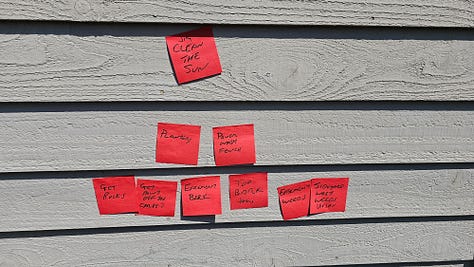We Must Survive Contact with Reality
Collaboration, communication, and clear thinking are our only allies.
No Plan Survives Contact with Reality, But WE Need To.
We humans are great at making plans, we humans suck at planning. In business and at home, life rarely unfolds according to our carefully crafted plans. We estimate, we project, we convince ourselves that our vision of the future is not only possible but probable, and then reality intervenes with its own agenda, often aided and abetted by unhelpful agendas from others.
This disconnect between expectation and outcome isn't just disappointing; it can be profoundly disorienting, especially when we've built our future plans on assumptions that suddenly evaporate.
My own experience selling a house in Seattle is a painful illustration. The market was strong, all indicators pointed to a quick sale—until suddenly, the day we listed, housing inventory surged by 300%. What should have been a straightforward transaction has stretched into an extended limbo that neither my wife nor I anticipated. This has put a future we spent years planning and preparing for on-hold, and adding some significant financial penalties on top of it.





Taking Things Personally
This experience isn't unique, but it certainly feels very personal. Despite that, this is a very human situation. We plan and those plans go beyond plan (steps to achieve a potential goal) and become expectations (outcomes we believe are guaranteed to happen).
When expectations don’t happen, the plans they are attached to become threatening. Your future is no longer tied to the plan, but the expectation. This happens when you go to the store and want a certain type of tomato or in business when people create Gantt charts and metrics assuming that people will meet dates or numbers.
And when the expectation fails, people are disappointed. And disappointed humans are very dangerous to themselves and others.
So, there are a few models that help us here. Let’s quickly list them so we can get to the meat of this post:
The Laws Working Against Our Plans
Hofstadter's Law:
The most helpful, and annoying quote in management is Douglas Hofstadter’s, "It always takes longer than you expect, even when you take into account Hofstadter's Law." We underestimate completion times, effort, complexity, the need to collaborate, the impacts of overload, and so much even when we know for a fact that we do this all the time. The self-reference part of this is funny, but is shows how optimism bias always colors our plans. We “think in colors everywhere…we’re like a rainbow.” ~ M. Jaggar
The Planning Fallacy:
Kahneman and Tversky go even deeper giving scientific weight our tendency to underestimate the time, costs, and risks associated with future actions while overestimating the benefits. This isn't just poor planning, this is a legitimate cognitive bias that affects even experienced professionals who “should know better.” (ha ha) There’s a constant quoting of 85% of initiatives “fail” because of time management, but the number is bogus and just internet echoes. What we all do know, from personal experience, that things finishing on time and on budget are rare and, when they do happen, occur because something has been sacrificed (features, quality, or just screwing your vendors to eat the costs). Understanding Hofstadter’s Law and the Planning Fallacy, might help us engage in less “plans” and more “planning.”
Partners Face Uncertainty Together
Okay, here’s the important part.
When our plans derail, the stress doesn't affect just one person—it ripples through relationships, creating a shared crisis that can either strengthen or strain bonds. The fact that an expectation has not been achieved means there is loss. Loss is a big thing. In the office, at home, and increasingly since those overlap…both.
Partners often experience different emotional responses at different times with different triggers to the same situation, creating additional tension precisely when unity is most needed. So, the house currently in limbo and straddling our future, our current state, our income, our expenses, and in a world where “leaders” are more intent on fear, uncertainty, and doubt, than any type of stability … and you have a lot of emotion, options, distractions, and moments of reaction.
Make You Clear, Let Them Be Clear
At this time, explicit stress communication between partners is crucial. It gets old, I will tell you that right now, talking about what is going on. It feels like fixation and both of us find ourselves saying “I can’t deal with that right now.” But that sentence is now more of a “I hear ya” than a check-out (which it was at the beginning) as we go deeper into this situation. But don’t hide that reaction. Don’t be fake-strong. If you do, I guarantee you one person will be fake strong better, become the “strong one”, and the other person will fall apart as the “strong one” soaks up all the PTSD.
Just be honest and move forward.
We’ve found that, even when one of us drops into a funk, being clear that it is happening leads to better outcomes and fewer depressive symptoms for both of us. The key insight is that uncertainty becomes more manageable when it's shared openly rather than suffered separately. And no, we aren’t perfect at this.
Visual Systems for Navigating Uncertainty Together
You’ve seen my posts here on Substack with crazy visuals lately and they won’t go away. Many of these are “commitment devices,” short term, high impact visualizations that keep you and your team / family focused when distraction rules.
My wife is very “not visual” but even she sees what I’m doing, uses the visuals when she can, and gets reassurance that they are there and knowing her husband cares about her and is working with her to fix things. And yes, she even suggests some visuals sometimes. 😊
Creating a Shared Visual Space
Yes, I go Obeya-happy when navigating uncertainty. An Obeya is a place where we have everything we need to do shown visually so everyone knows what is coming up, what is in flight, what is stuck, what requires both of us or one of us, and we know certain things about certain types of work (like Jim is not allowed to do the dishes).
Even with Vivian’s “non-visual” nature, we are using an Obeya to:
1. Make the situation visible - Display the current reality, options, and constraints so both partners can see the complete picture.
2. Track progress and changes - Update information in real-time to maintain a shared understanding.
3. Highlight decision points - Identify when and how decisions need to be made together and … I cannot stress this enough … to remember the decisions you have made.
I’m going to say that again. Remember the decisions you have made. You are both under pressure. You are both doing a million things and living with the stress. You will forget the decisions you have made or feel like you need to make them over and over again. This is a great way for people to flip out. Circumvent this extremely easy to avoid problem. Make a decision, write the damn thing down, slap it on the wall with any notes it might need. But, if you take anything from this, protect the people you love and yourself and just do this one thing.
Personal Kanban for the Freaked Out Couple
I would be remiss if I didn’t do this part. Personal Kanban, our Shingo award-winning method (get the book!) of visualizing work and limiting work-in-progress, will help you and your family navigate uncertainty together. Really quickly, you can take the class or buy the book to go deeper:
1. Create a Personal Kanban with columns representing different states (Options, Investigating, In Progress, Blocked, That Didn’t work, Complete)
2. Write each task, option, or concern on a card or sticky note
3. Move the cards across the board as their status changes and make sure you announce it to everyone
4. Limit how many items you're actively working on to prevent overwhelm, like three things at a time at most, but in stress, try one or two
5. Look at My Columns which are designed to relate to stress and change. The “that didn’t work” column is important as it creates an expectation that some things won’t work and it is no one’s fault, it’s just how things … don’t work.
6. Meet at the Board once a day, if not more, meet at the board and make sure that new stuff that needs to be added is added. One of the worst things that happens in stress times is scope creep or the idle “I should do that” that you don’t do and regret later.
This system creates a shared visual language that reduces misunderstandings and helps you and your family coordinate efforts without constant verbal realignment (verbal realignment is a technical term for nagging).
I think the Jedi said: Pain leads to nagging, nagging leads to bickering, bickering leads to suffering.
Transforming Uncertainty Together
When plans collapse in on us, the soul-crush weight is equal to the weight of the expectations cubed.
And expectations weigh a lot.
Our natural response is to invent immediate solutions and certainty. We rush to judgement, we skip analysis, and we blame, resent, and distance. And that’s not good. Wishful thinking and avoidance does not solve problems. It definitely escalates them.
You see this in the office, online, and at home. Our escalation skills are honed, our solving skills are dulled.
The most powerful approach is to become better at navigating uncertainty together, collaboratively. Trying to eliminate it prematurely or delegate it is ignoring the wind. The wind can propel you, stall you, capsize you, but it is only the wind.
By making your situation visible, maintaining alignment visually, and focusing on supporting each other through the frustration, we and you can transform periods of uncertainty from relationship threats into opportunities for deeper connection and resilience.
Remember that the goal isn't a perfect plan, it's creating a partnership capable of adapting together when plans inevitably change. By visualizing your work, limiting your focus to what truly matters, and maintaining connection through communication with just a little structure, you and your partner can find your way through even the most unexpected detours.
Our house will eventually sell, the uncertainty will resolve. We are building the capacity to navigate life's inevitable surprises together. Please take this as an opportunity to do the same. I am certain it will serve you long after any particular challenge fades into memory.
Modus Institute | The Personal Kanban Book | The Personal Kanban Class





I told my hubby from the start, "We'll only be happy if we stop having expectations of each other." Twenty-four years later, it still works.
Given: frustration is the difference between expectations and reality
Then: in most contexts, we face a formidable challenge
As you point:
* We turn our (impossible) plans into expectations
* We deflect consequences (blame, pain, etc.) to others to "protect" ourselves
But we also make the thing worse in the first place by skipping the alignment. That was a difficult lesson for me.
A few years back, I thought we were doing very well with transparency/visualization, and quite well with avoiding the blame game and other such tactics. And then it all blew out in our hands.
In retrospect, it was an impossible misalignment of expectations. Not even their scale (which often is a simple output of too optimistic plans), but their direction. One can't move an organization in two opposite directions, let alone five. And when some people at the same time believe that their desired agenda will happen, then everyone is bound to get dissatisfied.
Thus, as you point out, the need for making all the decisions visible (and in a way that doesn't drown them in an ocean of noise, let me add).